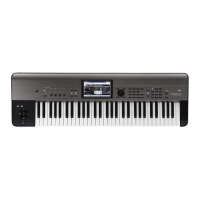Program mode
28
3–2: Filter1 Keyboard Track
This page contains the settings for Oscillator 1’s filter
keyboard track. Among other things, you can:
• Set up complex keyboard tracking shapes, and control
how the tracking affects filter cutoff.
Filter B is available when the Filter Routing is set to Serial
or Parallel. Otherwise, the parameters for Filter B will be
grayed out.
3–2a: Keyboard Track
Most acoustic instruments get brighter as you play higher
pitches. At its most basic, keyboard tracking re‐creates this
effect by raising the lowpass filter cutoff frequency as you
play higher on the keyboard. Usually, some amount of key
tracking is necessary in order to make the timbre consistent
across the entire range.
The KROME keyboard tracking can also be much more
complex, since it allows you to create different rates of
change over up to four different parts of the keyboard. For
instance, you can:
• Make the filter cutoff increase very quickly over the
middle of the keyboard, and then open more slowly or
not at all in the higher octaves.
• Make the cutoff increase as you play lower on the
keyboard.
• Create abrupt changes at certain keys, for split‐like effects.
How it works: Keys and Ramps
The keyboard tracking works by creating four ramps, or
slopes, between five keys on the keyboard. The bottom and
top keys are fixed at the bottom and top of the MIDI range,
respectively. You can set the other three keys named Key
Low, Center, and Key High to be anywhere in between.
The four Ramp values control the rate of change between
each pair of keys. For instance, if the Lo Cent (Low-Center)
Ramp is set to 0, the value will stay the same between the
Key Low key and the Center key.
The Key value will be the break point, and the slope of the
lower and higher regions on the keyboard is specified by the
Ramp.
At the Center key (the main hinge), the keyboard tracking
has no effect.
Intensity to A [–99...+99]
This controls how much the keyboard tracking will affect
Filter A’s cutoff frequency. The overall effect of the Keyboard
Track is a combination of this Intensity value and the overall
Keyboard Track shape.
With positive values (+), the effect will be in the direction
specified by keyboard tracking; if the ramp goes up, the
filter cutoff will increase.
With negative values (–), the effect will be in the opposite
direction; if the ramp goes up, the filter cutoff will decrease.
Keyboard Track Shape and Intensity
Intensity to B [–99...+99]
This controls how much the keyboard tracking will affect
Filter B’s cutoff frequency.
Key
Key Low [C–1...G9]
This specifies the note at which the two sloped lines in the
lower range will be connected.
Center [C–1...G9]
This specifies the note that will be the break point for the
center of keyboard tracking. At this key, the keyboard
tracking has no effect on the filter cutoff, or on any AMS
destinations.
Key High [C–1...G9]
This specifies the note at which the two sloped lines in the
upper range will be connected.
Note: You can also set the note value and velocity value by
holding down the edit cell or the ENTER button and playing
a note on the keyboard (see OG p.10).
Ramp
Positive ramp values mean that the keyboard tracking
output increases as you play farther from the Center Key;
negative ramp values mean that it decreases.
Because of this, the meanings of positive and negative ramp
settings will change depending on whether the ramp is to
the left or right of the Center Key.
Btm Lo (Bottom-Low) and Lo Cent (Low-Center): negative
ramps make the keyboard tracking’s output go down as you
play lower on the keyboard, and positive ramps make the
output go higher.
Cent Hi (Center-High) and Hi Top (High-Top): negative
ramps make the keyboard tracking’s output go down as you
play higher on the keyboard, and positive ramps make the
output go up.
The effect on the filter cutoff is a combination of the ramp
values, as set below, and the Intensity to A (B) parameters.
When Intensity to A (B) is set to +99, a ramp of 50 changes
the filter frequency by 1 octave for every octave of the
keyboard, and a ramp of +99 changes the frequency by 2
octaves for every octave of the keyboard.
Low Break Key Center Key High Break Key
Intensity = +99 (Original Shape)
Intensity = –99 (Inverted)

